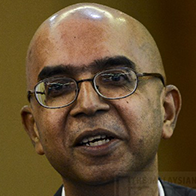On Thursday I was disappointed by a summit on affordable housing. The summit, organised by ASLI and REI group, boasted many heavyweights as panellists and moderators: CEO’s, Datuk Seri’s, even a Raja. They represented developers, statutory bodies and manufacturers. Deputy Minister for Urban Wellbeing, Housing and Local Government, Datuk Halimah Sadique gave the opening address.
I attended because I wanted to evaluate the prospects for house ownership for the 50% of Malaysians households whose monthly incomes are below RM 3,626. (The summit brochure said a 2013 survey found “the average median income” to be RM 3,200.)
I had hoped to get a definition of “affordable housing,” learn the promises the government has made about housing, and learn the status of these promises.
To my surprise, panellists did not refer to any agreed definition of “affordable housing.”
When I got home, I found the National Housing Policy (NHP) issued by the Ministry of Housing and Local Government in February 2011. In the introduction Deputy Prime Minister Tan Sri Muhyiddin Yassin says the private sector will continue to fulfil the overall housing demand while the public sector will focus on affordable housing for the low-income group.
The NHP says, “In the 10MP [10th Malaysia Plan], the government has targeted 78,000 units of affordable houses to be built, consisting of 38,950 units under the People’s Housing Program (PHP) and 39,050 units under programmes related to the Ministry of Rural and Regional Development to meet the needs of the low income groups and squatters.”
The NHP defines the low income group as those who “earn a monthly household income of less than RM2,500.”
So, per the NHP, affordable housing is intended for households who earn less than RM2,500 per month.
The NHP says the middle income group earn a monthly household income from RM2,500 to 3,999.
According to the NHP, the 10MP includes an allocation of RM500 million “for the repair and maintenance of public and private low cost housing.
This fund will be disbursed on a matching grant basis, where half the cost will be borne by the government and the other half by the management committee or resident’s association.”
The NHP says, “the government has decided that drastic steps will be taken to overcome problems pertaining to housing especially involving the poor and hardcore poor.”
These steps include:
1. Offering 44,000 units of existing low-cost houses for sale or rent through the Kuala Lumpur City Hall (DBKL) and the National Housing Department (JPN);
2. Providing 50,000 units of new and rehabilitated houses for the urban poor and hardcore poor by 2012, two-thirds of which will be in Sabah and Sarawak.
3. Ensuring only eligible recipients receive housing aid. Recipients are identified by district or state agencies through the e-Kasih portal, a national database for capturing data on low-income households; and
4. Offering financial assistance for initial deposits, legal fees and low-interest loans for the low-income households who are not recipients of or do not purchase public low-cost houses.
Two other bits in the NHP caught my attention:
First, “Based on the data captured under Computerized Open Registration System (SPT) managed by the MHLG, from 1 January 2009 to 31 August 2010, 20,426 applicants have registered to own or rent low-cost houses nationwide. Moreover, as of 30 June 2010, census conducted by state governments showed that 90,282 squatter families have yet to be relocated.”
Second, “Setting prices for low-cost houses as well as controlling ownership and sales to avoid speculation.”
I am surprised no one reviewed the status of the “drastic steps” described in the 10MP.
I left with six key insights:
1. Developers propagate the view that “affordable” means housing valued at less than RM500,000. Per national data (National Property Information Centre, 2014 Report, Table 4), this amounts to 84% of all 2014 residential property transactions.
2. The terms “low cost” and “affordable” are unattractive as they signal members of a lower social class. “Starter housing” sounds better.
3. There are thousands of completed, unsold, unoccupied homes valued under RM60,000 per unit.
4. Financing is a key issue: in one project 90% of loan applications were denied by banks. The key hindrances to loan success is said to be lifestyle choices. 5. People buy cars, smartphones, etc. with loans, leaving insufficient disposable income to service housing loans. CCRIS, Bank Negara’s Central Credit Reference Information System, works very well.
5. Collection of maintenance fees is a massive problem; typically 50% of owners don’t pay.
6. “Rent-to-buy” may solve the financing and maintenance woes, but no one is working on this.
What will the 11MP say about squatters, rehabilitation, low cost housing, SPT, e-Kasih, controlling speculation, medium cost housing, awards of financial assistance and purchasing assistance? What will it propose to improve the housing situation?
Does the government have the will solve the housing problem?– April 30, 2015.
This is the personal opinion of the writer or publication and does not necessarily represent the views of The Malaysian Insider.


Comments
Please refrain from nicknames or comments of a racist, sexist, personal, vulgar or derogatory nature, or you may risk being blocked from commenting in our website. We encourage commenters to use their real names as their username. As comments are moderated, they may not appear immediately or even on the same day you posted them. We also reserve the right to delete off-topic comments